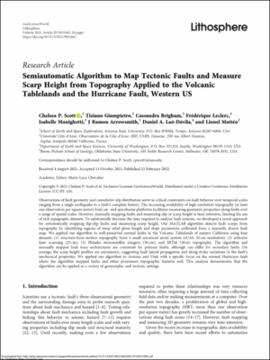| dc.contributor.author | Scott, Chelsea P. | |
| dc.contributor.author | Giampietro, Tiziano | |
| dc.contributor.author | Brigham, Cassandra | |
| dc.contributor.author | Leclerc, Frederique | |
| dc.contributor.author | Manighetti, Isabelle | |
| dc.contributor.author | Arrowsmith, J. Ramon | |
| dc.contributor.author | Lao-Davila, Daniel A. | |
| dc.contributor.author | Matteo, Lionel | |
| dc.date.accessioned | 2022-04-19T20:18:16Z | |
| dc.date.available | 2022-04-19T20:18:16Z | |
| dc.date.issued | 2022-02-23 | |
| dc.identifier | oksd_laodavila_semiautomaticalgorithm_2022 | |
| dc.identifier.citation | Scott, C. P., Giampietro, T., Brigham, C., Leclerc, F., Manighetti, I., Arrowsmith, J.R., ... Matteo, L. (2021). Semiautomatic algorithm to map tectonic faults and measure scarp height from topography applied to the Volcanic Tablelands and the Hurricane fault, western US. Lithosphere, 2021 (Special Issue 2), Article 9031662. https://doi.org/10.2113/2021/9031662 | |
| dc.identifier.uri | https://hdl.handle.net/11244/335257 | |
| dc.description.abstract | Observations of fault geometry and cumulative slip distribution serve as critical constraints on fault behavior over temporal scales ranging from a single earthquake to a fault's complete history. The increasing availability of high-resolution topography (at least one observation per square meter) from air and spaceborne platforms facilitates measuring geometric properties along faults over a range of spatial scales. However, manually mapping faults and measuring slip or scarp height is time-intensive, limiting the use of rich topography datasets. To substantially decrease the time required to analyze fault systems, we developed a novel approach for systematically mapping dip-slip faults and measuring scarp height. Our MATLAB algorithm detects fault scarps from topography by identifying regions of steep relief given length and slope parameters calibrated from a manually drawn fault map. We applied our algorithm to well-preserved normal faults in the Volcanic Tablelands of eastern California using four datasets: (1) structure-from-motion topography from a small uncrewed aerial system (sUAS; 20 cm resolution), (2) airborne laser scanning (25 cm), (3) Pleiades stereosatellite imagery (50 cm), and SRTM (30 m) topography. The algorithm and manually mapped fault trace architectures are consistent for primary faults, although can differ for secondary faults. On average, the scarp height profiles are asymmetric, suggesting fault lateral propagation and along-strike variations in the fault's mechanical properties. We applied our algorithm to Arizona and Utah with a specific focus on the normal Hurricane fault where the algorithm mapped faults and other prominent topographic features well. This analysis demonstrates that the algorithm can be applied in a variety of geomorphic and tectonic settings. | |
| dc.format | application/pdf | |
| dc.language | en_US | |
| dc.publisher | GeoScienceWorld | |
| dc.relation.ispartof | Lithosphere, 2021 (Special Issue 2) | |
| dc.rights | This material has been previously published. In the Oklahoma State University Library's institutional repository this version is made available through the open access principles and the terms of agreement/consent between the author(s) and the publisher. The permission policy on the use, reproduction or distribution of the material falls under fair use for educational, scholarship, and research purposes. Contact Digital Resources and Discovery Services at lib-dls@okstate.edu or 405-744-9161 for further information. | |
| dc.title | Semiautomatic algorithm to map tectonic faults and measure scarp height from topography applied to the Volcanic Tablelands and the Hurricane fault, western US | |
| dc.date.updated | 2022-04-15T18:47:06Z | |
| osu.filename | oksd_laodavila_semiautomaticalgorithm_2022.pdf | |
| dc.description.peerreview | Peer reviewed | |
| dc.identifier.doi | 10.2113/2021/9031662 | |
| dc.description.department | Geology | |
| dc.type.genre | Article | |
| dc.type.material | Text | |
| dc.subject.keywords | 0402 Geochemistry | |
| dc.subject.keywords | 0403 Geology | |
| dc.subject.keywords | 0404 Geophysics | |
| dc.rights.license | https://creativecommons.org/licenses/by/4.0/ | |
| dc.relation.oaurl | https://pubs.geoscienceworld.org/gsa/lithosphere/article/2021/Special%202/9031662/610473/Semiautomatic-Algorithm-to-Map-Tectonic-Faults-and | |
| dc.identifier.author | ScopusID: 55974141300 (Scott, CP) | |
| dc.identifier.author | ScopusID: 57222623191 (Giampietro, T) | |
| dc.identifier.author | ScopusID: 57224940639 (Brigham, C) | |
| dc.identifier.author | ScopusID: 55240245200 (Leclerc, F) | |
| dc.identifier.author | ScopusID: 6603447302 (Manighetti, I) | |
| dc.identifier.author | ScopusID: 24779656700 (Arrowsmith, JR) | |
| dc.identifier.author | ORCID: 0000-0003-0584-458X (Lao-Davila, DA) | |
| dc.identifier.author | ScopusID: 35105202100 (Lao-Davila, DA) | |
| dc.identifier.author | ScopusID: 56685406200 (Matteo, L) | |
